
Prenatal Pilates Exercises Safe During All Trimesters
10 min readWritten by Simran Dolwani

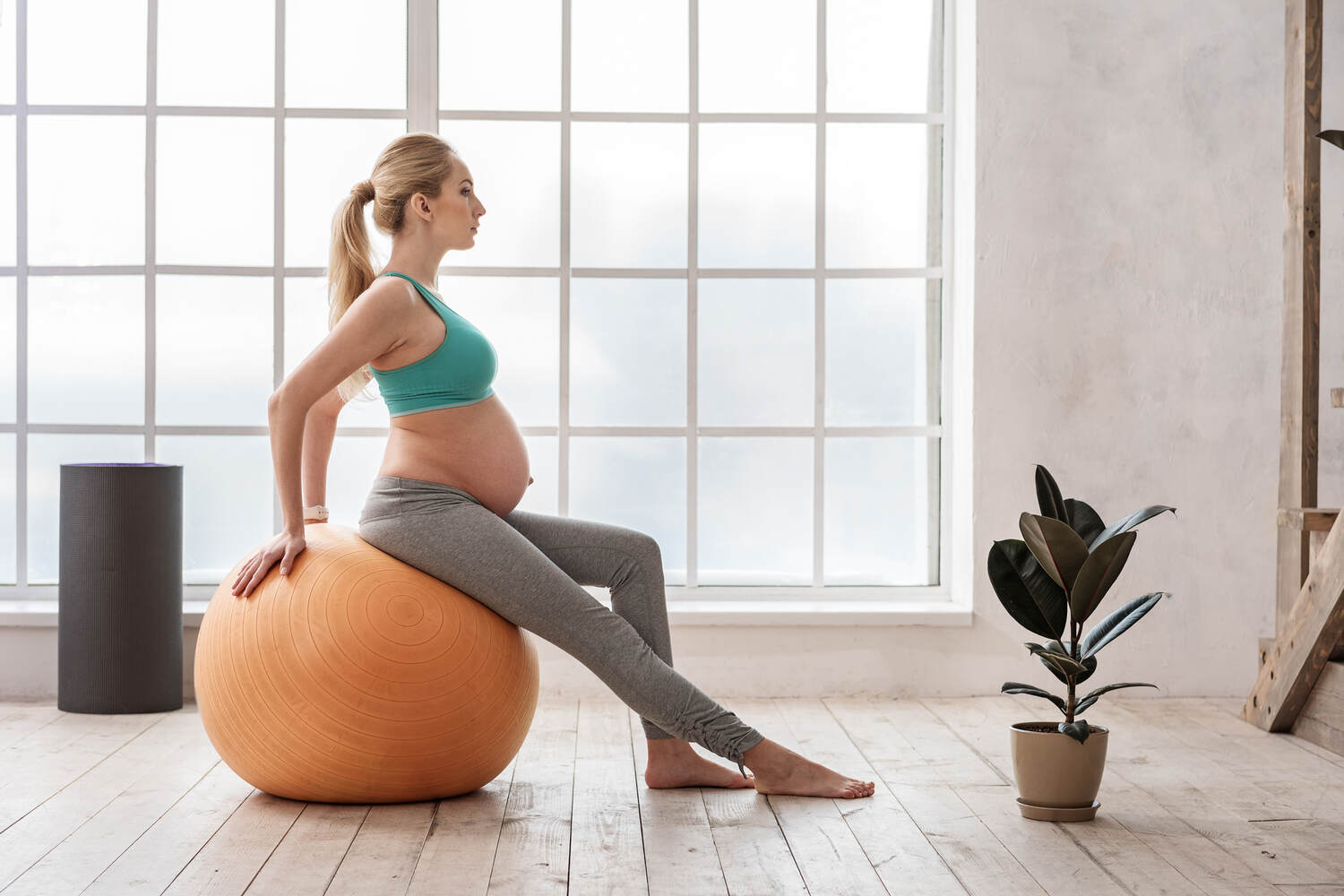
Pregnancy is a time when the pregnant woman should be healthy and fit. There are a lot of discussions that go around the fitness regime that can be followed during this period. Many doctors encourage walking during pregnancy. There are so many options available to keep oneself fit during pregnancy. Yoga is also considered the best bet to stay fit during pregnancy. Zumba, cardio, etc., are some of the other popular fitness regimes during pregnancy. Therefore, choosing an appropriate fitness regime is somewhat tricky.
Out of all of these, Pilates is an exercise that has a low impact on the body and offers power and makes the body flexible, though not all activities are suitable during pregnancy. Going forward, we will discuss the Pilates workout regime and the precautions that should be taken for secure and effective exercises.
In This Article
- What is Pilates?
- Is it Safe to do Pilates During Pregnancy?
- Amazing Benefits of Doing Pilates While Pregnant
- List of Top Nine Prenatal Pilates Exercises(Suitable For All Trimesters)
- Pilates Exercises to Avoid During Pregnancy
- Precautions For an Effective Pilate Workout
- Yoga Vs. Pilates For Pregnancy
- FAQs
What is Pilates?
Pilates is one of the most common exercises which can be done to improve the overall fitness during pregnancy. . Its focus is to enhance the movements of the body and the posture as well. The movements are centered on the lower muscles of the abdomen, the back muscles, and the pelvic muscles, which are crucial for the balance, strength, and posture of the body. These exercises during pregnancy can be done either on a mat or by using fitness instruments like exercising balls, resistance bands, trapeze tables, etc.
Is it Safe to do Pilates During Pregnancy?
As per research, it is safe to perform Pilates through all three trimesters of pregnancy, but only after getting the go-ahead from the doctor [1]. Pilates is not a very unsafe bet and is very gentle as an exercise, yet overexertion should be avoided, and the body should not be overstretched as well. All types of exercises in Pilates can be done in the first few weeks of pregnancy, but one needs to be cautious after the 16th week, and all sorts of activities that involve sleeping on the back should always be avoided.
[Read: Exercise Ball During Pregnancy]
Amazing Benefits of Doing Pilates While Pregnant
All forms of exercise, specifically Pilates, center around the muscles and their functions that are susceptible to edema, improper balance, endurance, and posture throughout pregnancy.
Let us see the benefits of Pilates in pregnancy
- It makes the stomach muscles and gluteal muscles strong.
- Pilates enhances hip, pelvis, and lower back stability, which decreases injuries and pain [2].
- The back pain during pregnancy is relieved as Pilates makes the posture strong.
- Pilates strengthens the pelvic floor muscles and even offers support to the bladder, and uterus as the baby starts to descend with the increasing weight of the mother [3].
- Pilates enhances flexibility and even helps in controlling breathing to ease labor and delivery.
- With the passing phase of time and the increasing weight of the baby, the mother tends to become clumsy, and practicing Pilates makes core strength and improves the balance of the body, preventing you from slipping or falling during pregnancy [4].
- The four points kneeling position on the hands, as well as knees, helps to lessen the load, which is on the lower back portion and the pelvis.
- By practicing Pilates on a regular basis, the excess gain of weight can be prevented throughout pregnancy [5].
- Leg cramps, fruit retention, and varicose veins are yet another feature throughout pregnancy, and practicing Pilates strengthens the legs and reduces all complications that can happen during pregnancy.
- Pilates is an ideal way to relax and keep away from stress [6].
- Pilates is the best way to reduce the fatigue one experiences postpartum.
- It can even reduce threats of depression.
- Pilates also helps to keep the mother and the newborn baby healthy.
List of Top Nine Prenatal Pilates Exercises (Suitable For All Trimesters)

Pilates is an excellent choice for the mother and the baby. It has its own set of advantages as well. There are a set of nine exercises that are good as well as safe for the mother and the baby. Let us now discuss these exercises in detail. The exercises that are safe for the mother and the baby are as follows:
1. Pelvic Floor Muscle Exercise
- It helps to offer strength to the pelvic floor muscles and helps in the prevention of any complications throughout the pregnancy and post-delivery.
- For this exercise, one needs to sit on knees and legs together, or even lie on the back with head in an elevated position and bent knees.
- The pregnant woman must behave as if she’s trying to control the need to urinate, and the muscles should feel the squeeze.
- One should stay in this position for about ten seconds and then relax slowly and steadily.
- Repeat this ten times.
2. Deep Tummy Strengthening
- This exercise helps to strengthen back support.
- One should lie sideways with knees that are bent slightly.
- Now inhale and exhale, trying to pull the tummy inwards.
- The pelvic muscles can also be made to squeeze simultaneously.
- The pregnant woman can remain in this posture for ten seconds or so.
- Now relax the muscles of the abdomen and repeat at least 8-10 times.
3. Pelvic Tilts
- This exercise helps to offer strength to the pelvis and the lower back.
- Lie backward with your head and shoulders in an elevated manner with the help of a pillow.
- Breathe inwards.
- While exhaling, press the lower back portion with the help of the muscles in the abdominal area.
- The pelvis and tailbone rise up once this exercise is practiced.
- Stay in this position for about 5-10 seconds.
- Strengthens your lower back and pelvis.
- Repeat for five or ten times.
4. Upper Back Stretch
- Doing this exercise helps to enhance posture.
- One needs to sit in a cross-legged position, and the back should be in an upright position with hands around the head.
- Inhale, but slowly.
- While exhaling, pull the tummy inwards and push the back of your body, pretending as if you are looking towards the ceiling.
- Breathe again by enfolding the shoulders and going back to the original position.
- Repeat this 5-10 times.
5. The Cat Stretch
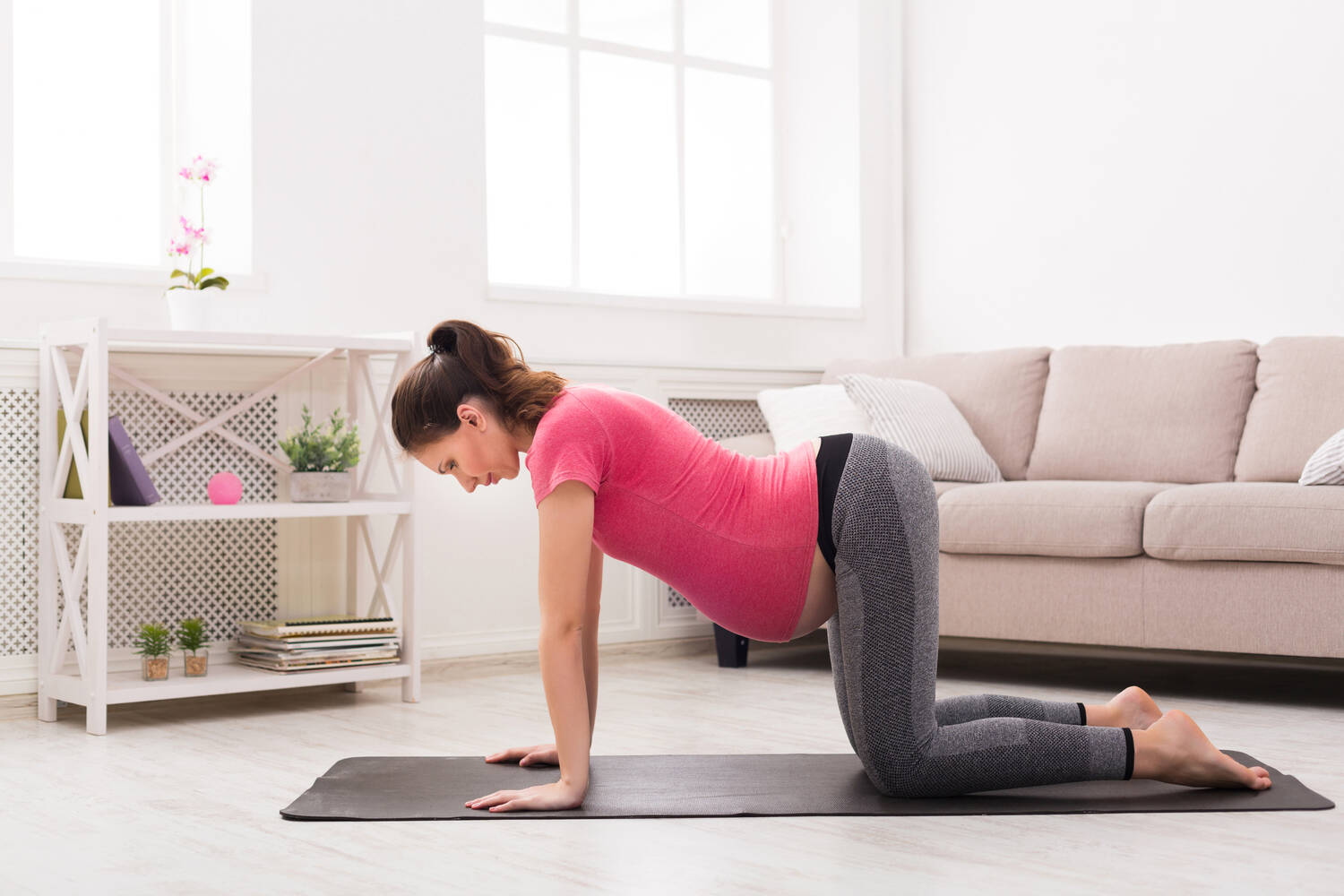
- This exercise offers strength to the muscles at the back of the body.
- Start this exercise by keeping the hands over the shoulders and knees behind the hips.
- Breathe inwards as the tummy becomes relaxed.
- While exhaling, pull the tummy inside and bend the back in an upwards position with the head in a downward position as if trying to look at the tummy.
- Breathe gently returning to the original position.
- Repeat 5-10 times.
[Read: Is It Safe To Bending Over During Pregnancy?]
6. Thigh Stretch
- This exercise offers strength to the muscles of the abdomen, lower back, buttocks, and hips.
- For this, the pregnant woman needs to kneel with knees and hips at a width apart and then pull the abs inwards.
- While inhaling, lean backward and try to enfold the butt.
- Now lift the arms with palms facing downwards and the arms running parallel to the ground.
- Exhale as you try to bring the arms downwards.
- Return to the original position.
7. The Sword
- This position helps to enhance the balance of the body and offers strength to the back, legs, and abdomen.
- Now stand with feet at a distance, which is wider than the hips.
- Bend the knees and hold the left knee with the right hand.
- Elevate the right hand upwards, pretending to pull a sword from the hip clasp.
- Repeat with the left side as well.
8. Sword Arm
- It enhances the body’s balance and offers strength to the back, arms, hips, and abs.
- The pregnant woman needs to kneel with the help of the right knee with both hands on the floor.
- Now stretch the left leg and pull the abs inwards and hips upwards.
- Inhale in and stretch the left hand towards the sky and then keep looking at your hands.
- Exhale and lower the hand to the original position.
- Now repeat the same with the left side.
9. Wagging the Tail
- This exercise enhances firmness, and flexibility, and even strengthens the abs and the lower back.
- Start this exercise by kneeling on both legs and wrists in line with the shoulders.
- Pull in the belly inwards by lifting one knee and then making circular motions by the leg.
- Now repeat with the other leg.
- Repeat the whole exercise three to five times.
[Read : 10 Physical Activities To Be Avoided During Pregnancy]
Pilates Exercises to Avoid During Pregnancy
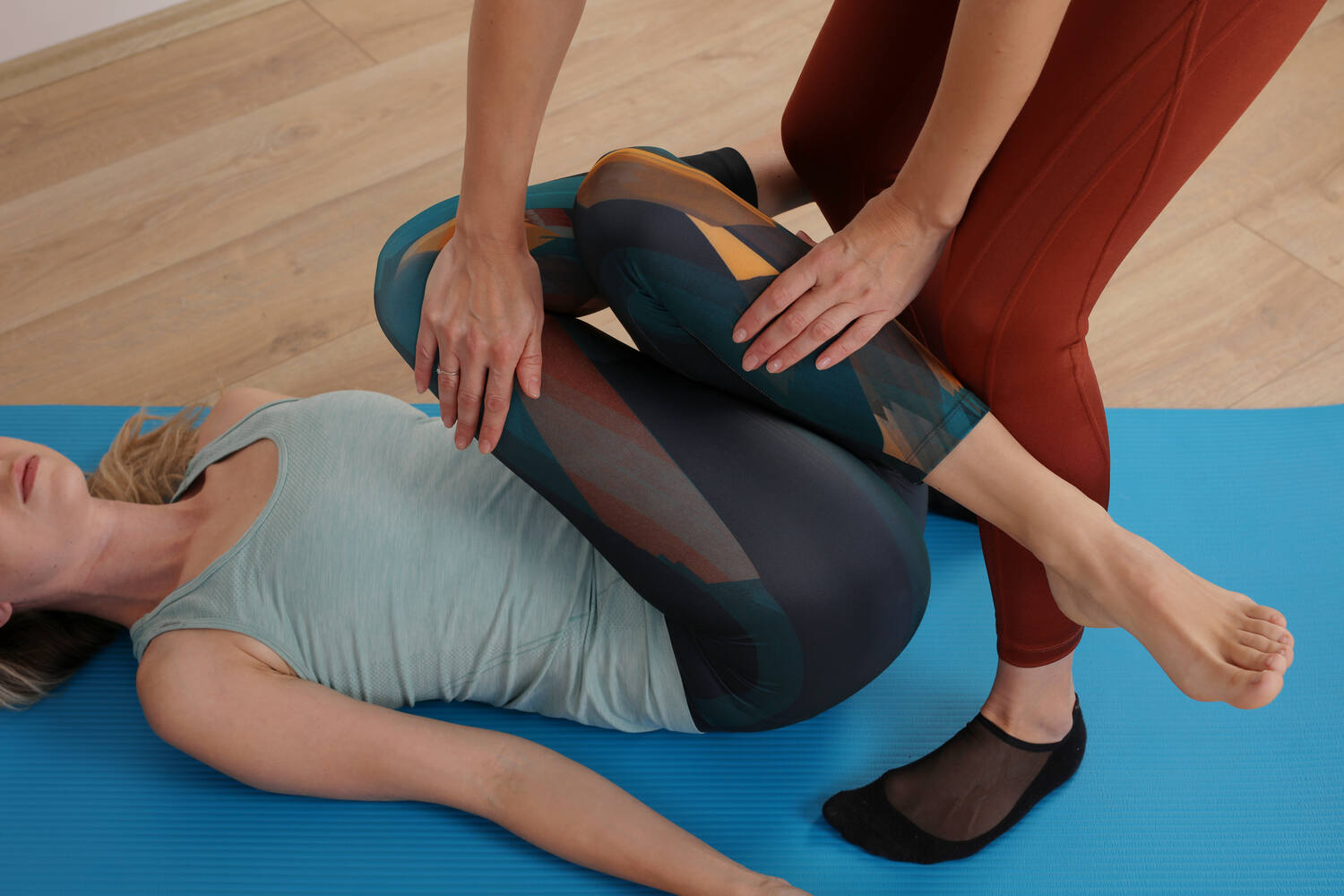 Pilates exercises are, no doubt, gentle and low-impact ones. They do not pose any harm to the mother and the baby, but there are a a few exercises that should be avoided throughout pregnancy. The list of ones that should not be done during pregnancy is as below.
Pilates exercises are, no doubt, gentle and low-impact ones. They do not pose any harm to the mother and the baby, but there are a a few exercises that should be avoided throughout pregnancy. The list of ones that should not be done during pregnancy is as below.
- Exercise that consists of stomach or back could result in hurting the body.
- Exercise that comprises lying on the back or contracting the rectum.
- Stretches that are done with the help of lying on the back and keeping one leg in a perpendicular position should be totally avoided.
- Exercise that comprises lying on the abdomen or face in a downward position.
Though all these exercises should be done only with the consent of the doctor and be cautious that the mother does not get hurt while performing these exercises.
Precautions For an Effective Pilate Workout
Pilates is always safe during pregnancy, and we have already discussed the positions that should be totally avoided to be safe and healthy. The pregnant woman, though, needs to be cautious and take the necessary precautions to prevent herself from injuries and reap maximum gains from practicing Pilates.
The precautions for an effective Pilates workout are as below:
- It is always wise to keep a veteran instructor who can help the pregnant woman with exercising effectively.
- Before starting the exercise, get the pelvic floor muscles, abdomen, and posture checked so that a suitable Pilates exercise can be practiced.
- It is always good to inspect the energy points and never overexert them.
- One should take precautions to avoid abdominal crunches and stretching the joints too much.
- Never wear too tight-fitting clothes, keep yourself comfortable.
- Keep the body balance with the increasing weight of the baby and get up from the floor slowly and steadily.
- Never lie flat or elevate the feet over the head in the second trimester as this can put pressure on the blood vessels resulting in decreased blood supply towards the heart.
- Pay attention to the pelvic floor muscles and posture in the last trimester of pregnancy.
- It is better to stop exercising in case one feels tired or fatigued.
- Keep yourself hydrated and avoid doing any exercises under hot temperatures and humidity.
- It is better not to exercise after eating immediately or on an empty stomach. It is best to keep a gap of a few hours.
Tips for Doing Pilates During Pregnancy
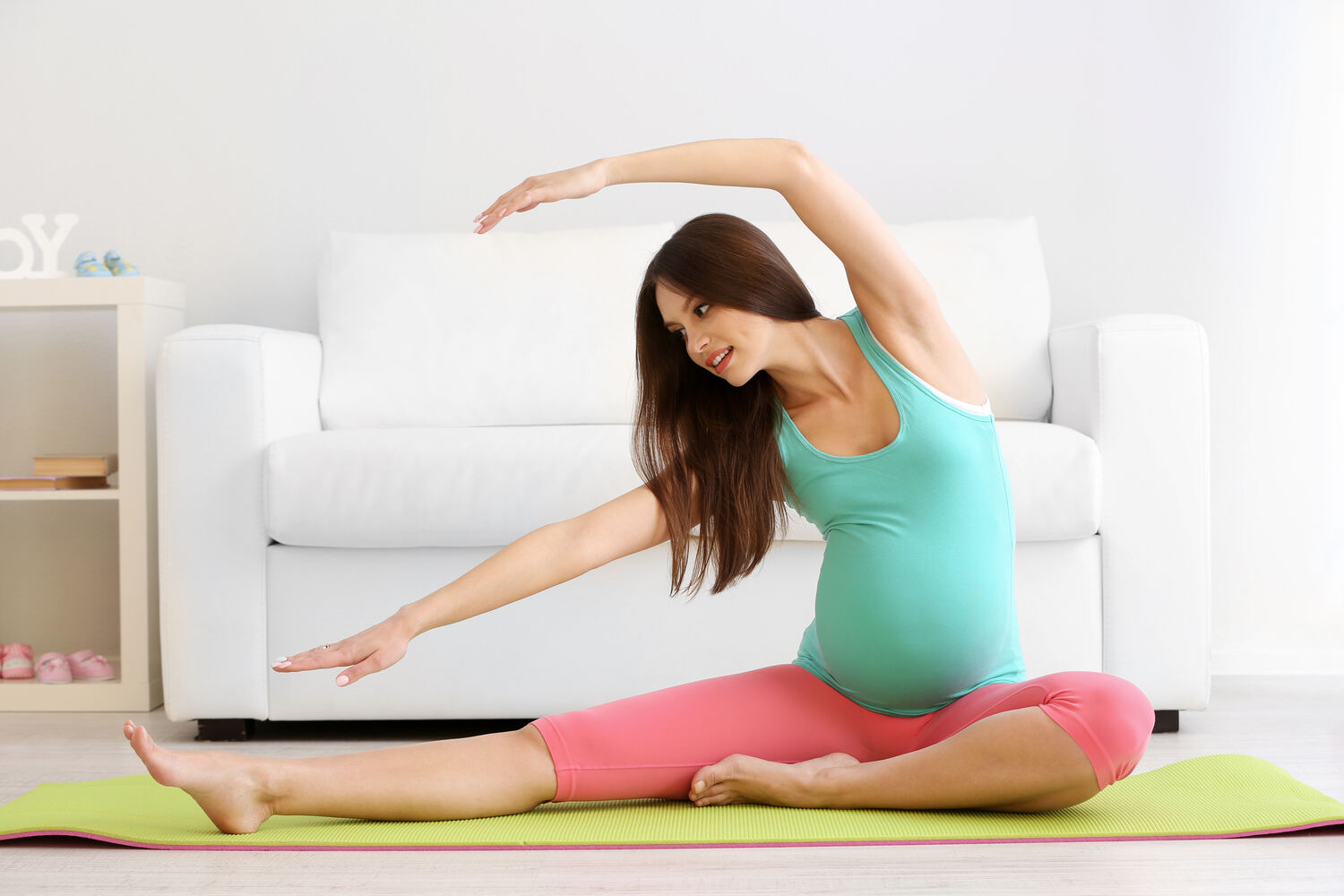 Pilates during pregnancy can be a great workout to strengthen your core while easing the delivery process (7). Here are some important tips to consider to enhance your exercise routine.
Pilates during pregnancy can be a great workout to strengthen your core while easing the delivery process (7). Here are some important tips to consider to enhance your exercise routine.
Do a Quick Warmup
It’s a good idea to do a quick warmup before starting Pilates. Take a few deep breaths and stretch your body a little to avoid any resistance during exercise.
Avoid Over-exercising
Be careful while exercising. It’s better to avoid overstretching- go easy on your body. Overdoing can increase the risk of injury. Hence, it’s significant to do as much as your body supports at regular intervals of relaxation.
Use Pillows
You can try doing the exercise using pillows to support your body if you feel uncomfortable while lying. Moreover, you can do Pilates on your hands and knees if lying doesn’t work for you.
Maintain Your Body Temperature
During exercise, maintaining your body temperature is crucial. High temperatures may impose a risk to the fetus. Moreover, it can make you feel more tired and increase the risk of injury. Therefore, it’s good to exercise in a spacious and well-ventilated room.
Consult Your Healthcare Provider
Before involving in any exercise routine, it’s important to consult with your doctor. This will reduce the risk of complications and ensure maximum safety. Plus, your physiotherapist may help you create a personalized workout routine based on your condition. For instance, if you have weak and separated abdominal muscles, you may avoid pilates exercises involving core strengthening.
Signs to Stop Doing Pilates During Pregnancy
Pilates is a safe exercise; however, if you experience discomfort, it’s better to stop them. Pilates should be avoided in conditions like fetal pain, vaginal bleeding, amniotic fluid leakage, contractions, dizziness, shortness of breath, etc.
Yoga Vs. Pilates For Pregnancy
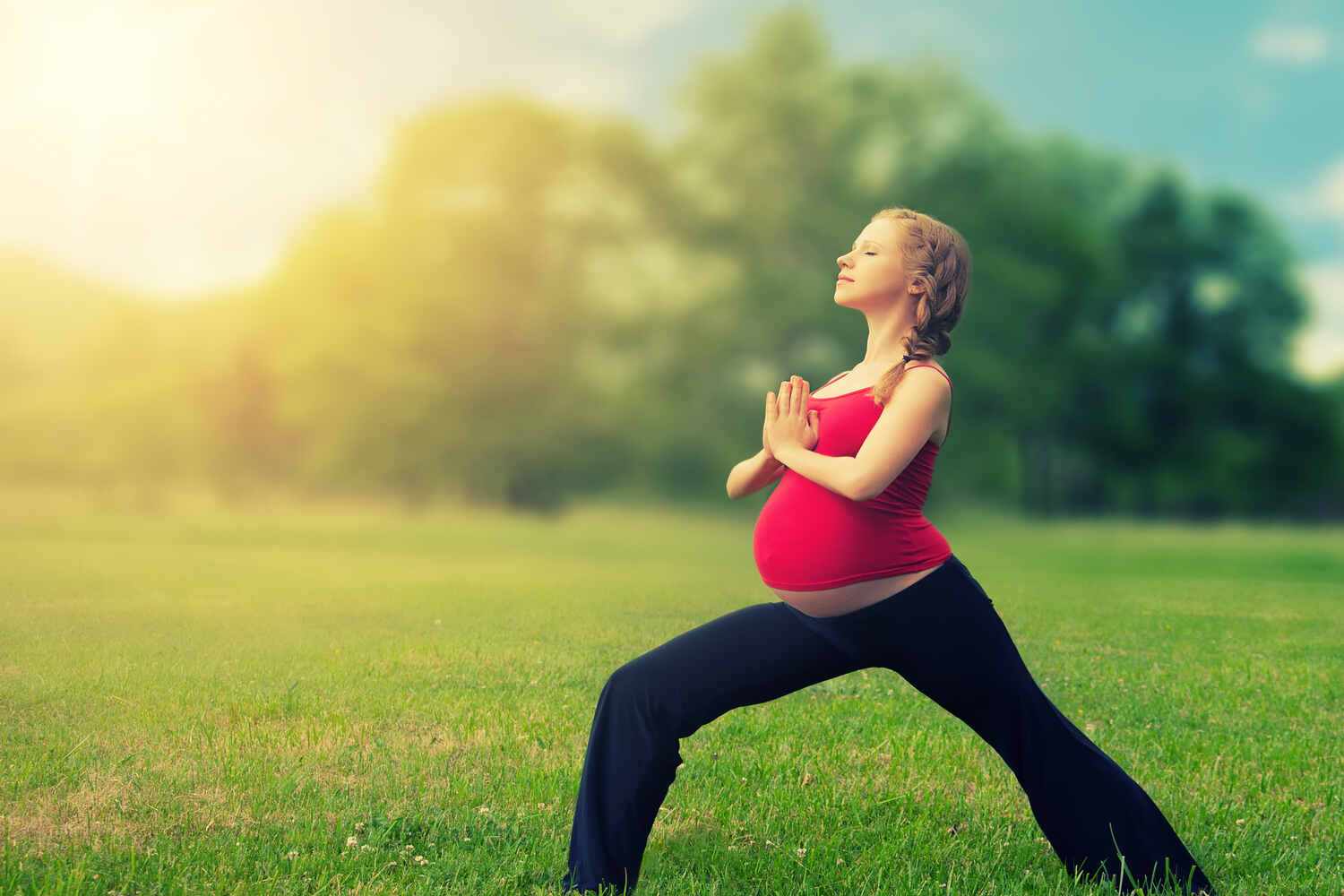
Yoga and Pregnancy are both ideal ways to keep oneself fit. There are some structural differences between both, but they both aim at keeping you fit and healthy. The differences between the two are stated as under:
- Pregnancy Pilates indicates working and making the muscles strong that are needed for the birth of the baby, but yoga pays more attention to the overall body.
- Pregnancy Pilates reassures the balance of the body, muscle strength, and coordination of body parts as well, whereas yoga enhances the overall body functions and reduces cramps, fatigue, aches, emotional well-being, etc.
Thus, pregnancy is a time to be healthy, happy, and fit. It is important to eat right and be full of nutrition, but at the same time, fitness should be done under experienced supervision and with proper precautions with proper consultation with the doctors. This is the most crucial phase of a woman’s life, and keeping healthy in the correct way is beneficial for both the mother and the baby.
Read Also: Yoga During Pregnancy – The Best Bet To Stay Fit
FAQs
1. When Should I Stop Prenatal Pilates?
After 12 weeks of pregnancy, it’s best to avoid activities that require you to lay on your back, since this might restrict blood supply to your developing baby.
2. How Do Pilates Exercises Affect Your Baby?
Pregnant women who continue to any kind of exercise properly throughout their pregnancies have babies who are healthier and who have a head start on cognitive development.
3. Does Pilates Help With Labor?
Prenatal Pilates has been shown to make labor less painful, shorten the active phase of labor, and make the second stage of labor shorter.
References-
-
Obstetric, maternal, and neonatal outcomes after Pilates exercise during pregnancy: A systematic review and meta-analysis
https://www.ncbi.nlm.nih.gov/pmc/articles/PMC10219711/ -
Efficacy of Pilates on Pain, Functional Disorders and Quality of Life in Patients with Chronic Low Back Pain: A Systematic Review and Meta-Analysis
https://www.ncbi.nlm.nih.gov/pmc/articles/PMC9956295/ -
Effect of a 12-Week Pilates Pelvic Floor-Strengthening Program on Short-Term Measures of Stress Urinary Incontinence in Women: A Pilot Study
https://www.ncbi.nlm.nih.gov/pmc/articles/PMC7044776/ -
Pilates to Improve Core Muscle Activation in Chronic Low Back Pain: A Systematic Review
https://www.ncbi.nlm.nih.gov/pmc/articles/PMC10218154/ -
Effects of the practice of Pilates in pregnancy: a literature review
https://www.researchgate.net/publication/343112648_Effects_of_the_practice_of_Pilates_in_pregnancy_a_literature_review -
The effects of Pilates and yoga participant’s on engagement in functional movement and individual health level
https://www.ncbi.nlm.nih.gov/pmc/articles/PMC6732550/ -
The effectiveness of a Pilates exercise program during pregnancy on childbirth outcomes: a randomised controlled clinical trial
https://bmcpregnancychildbirth.biomedcentral.com/articles/10.1186/s12884-021-03922-2

Simran Dolwani,Bachelors in Physiotherapy
Responses (0)
Want curated content sharply tailored for your exact stage of parenting?
Related articles

Dandruff During Pregnancy – Causes, Treatment Options, And Home Remedies
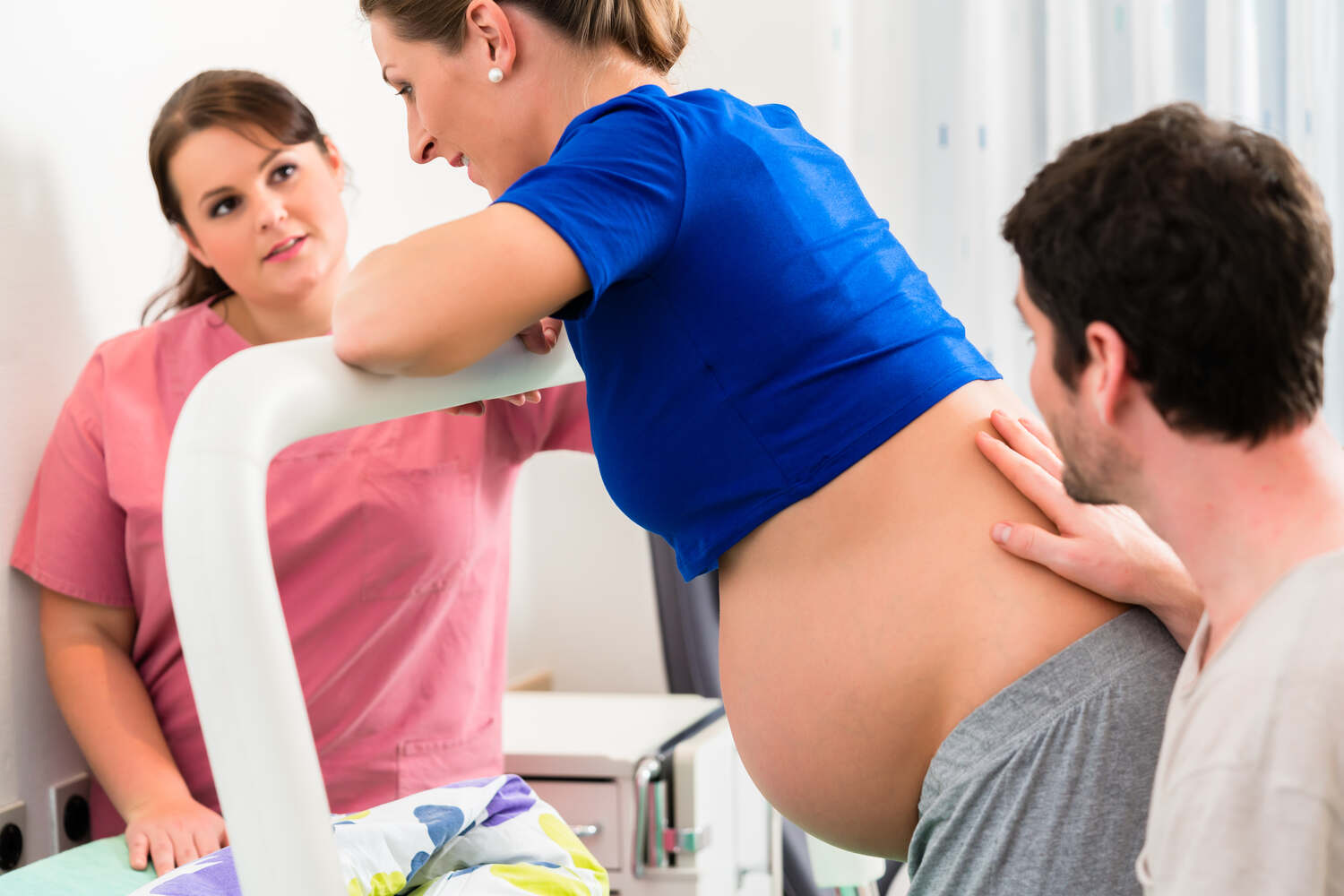
Nipple Stimulation to Induce Labor – How Does it Work and Tips to Perform
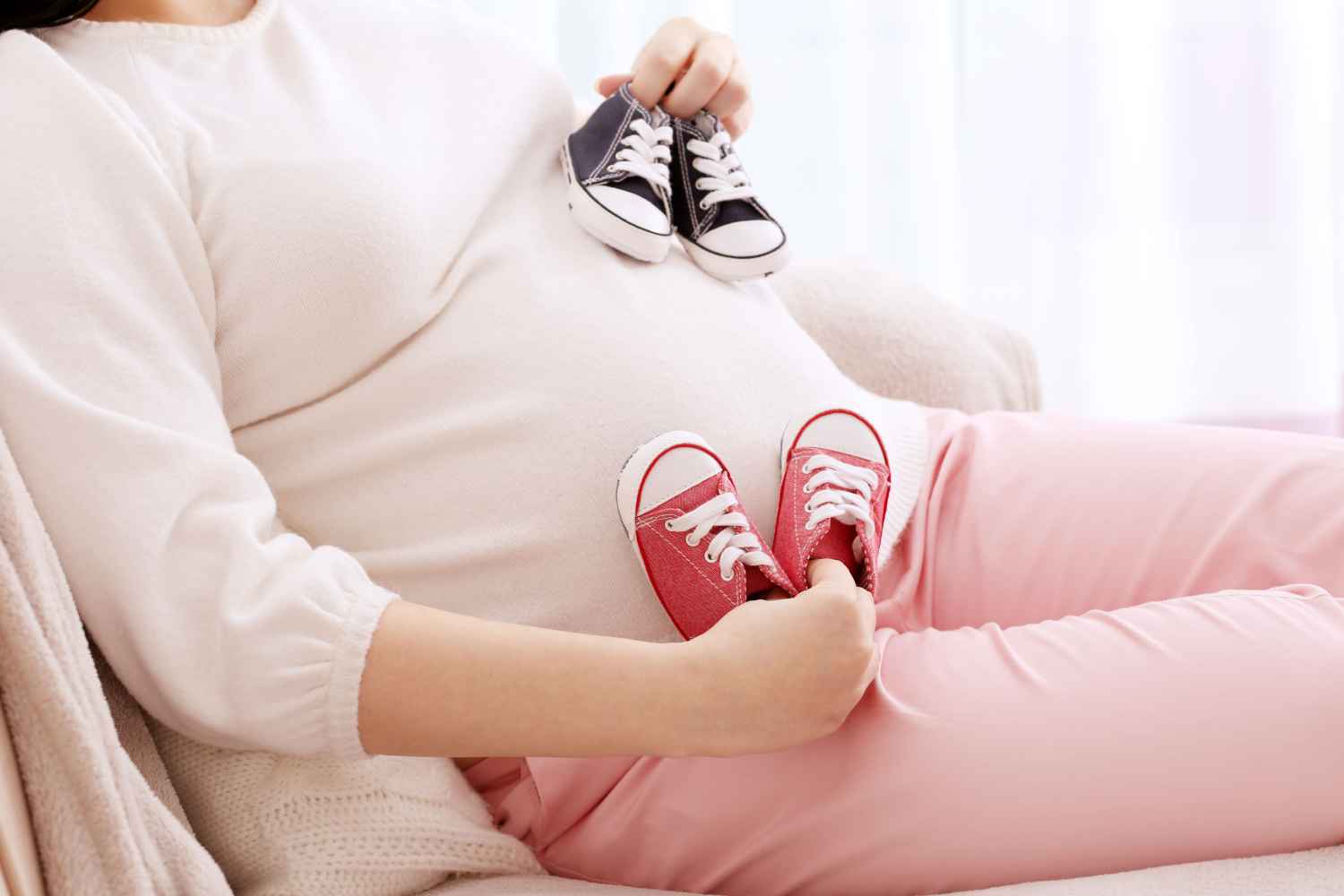
When Will I Know That I Am Carrying Twins?
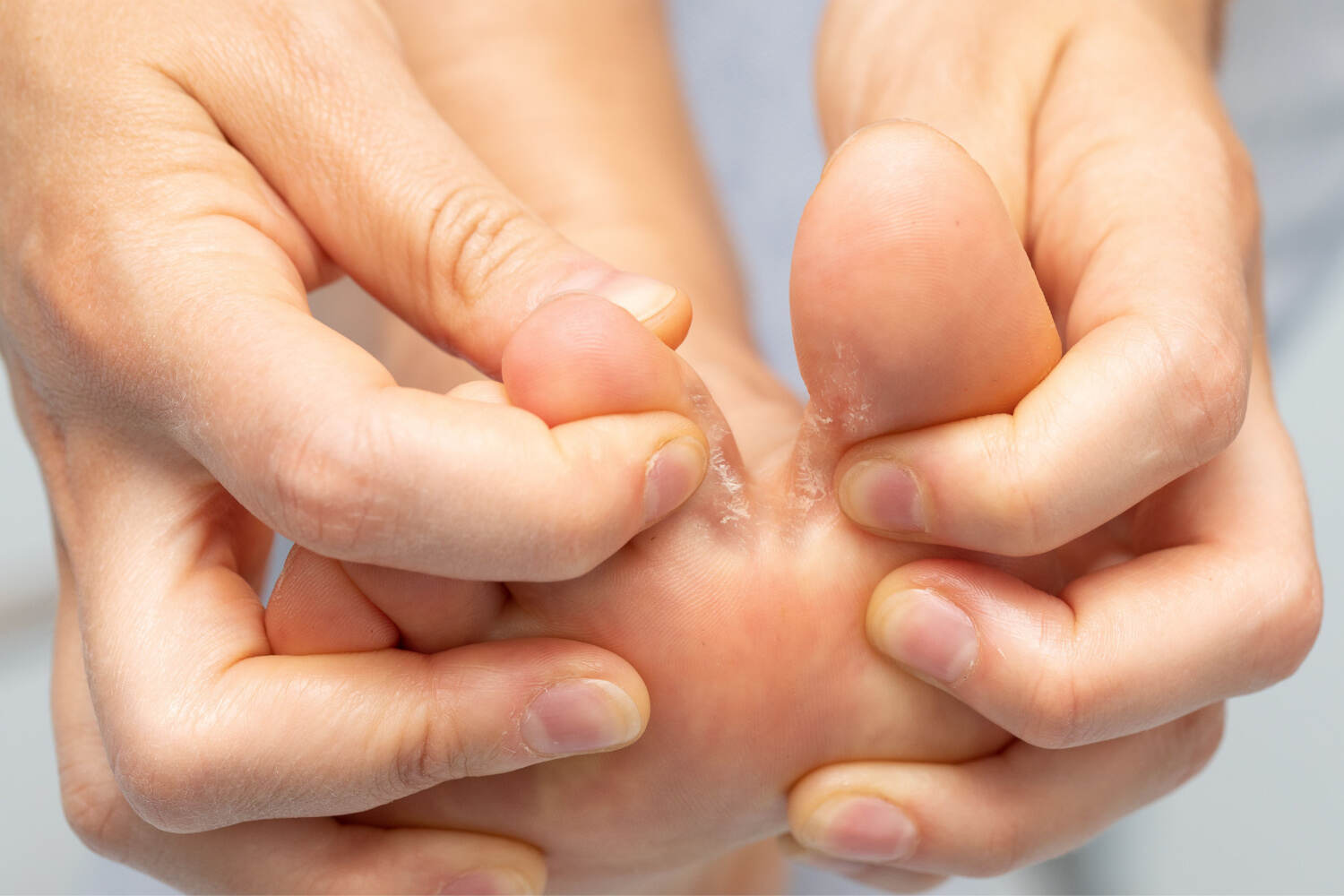
Athlete’s Foot During Pregnancy – Causes, Treatment And Home Remedies

Amniotic Fluid – It’s Role And Importance During Pregnancy

Cleaning During Pregnancy – Do’s And Don’ts
Sponsored content
Discover great local businesses around you for your kids.
Get regular updates, great recommendations and other right stuff at the right time.





